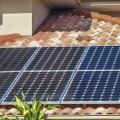Solar energy is a type of renewable energy that is better for the environment, so what is there that I don't like about it? Of course, like any technology, solar energy has its pros and cons. Whether it's commercial or residential systems2, different types of solar energy demonstrate the range of benefits we can expect from renewable energy. The history of photovoltaic solar energy dates back to around the 1830s, when the photovoltaic effect was discovered. Later, in 1954, Bell Laboratories in the United States built the first photovoltaic solar panel.
This form of solar energy is best suited to countries that see extremely high levels of sunshine. It is therefore not surprising that Spain has the largest capacity of 2,300 MW, while the United States and South Africa follow closely with 1,738 MW and 400 MW. Solar energy for water heating started with black paint painted on tanks and used to heat water. As the black paint absorbs heat from the sun, it heats the water inside.
As primitive as it may seem, it shows that we understood the power of solar energy from the beginning. Therefore, consumer demand has seen solar pool heating increase. This works in the same way as water heating, solar energy. Photovoltaic panels or panels containing thermal conductors capture heat from sunlight and convert it into energy and, in turn, into water.
Solar thermal energy, or solar thermal technology, uses heat from the sun to collect solar energy. To heat water or produce electricity, the liquid flows through the tubes and collects energy from the sun. Compared to solar photovoltaic energy, solar thermal energy is more space efficient. Solar thermal energy can offer up to 70% more energy efficiency when it comes to collecting heat.
Along with this, the technology is much less complex, which makes it ideal for heating water. The largest solar thermal power plant is located in Morocco and has a capacity of 510MW, while the United States and Spain have several large-scale projects. Because of the way solar thermal systems work, they can reach an extremely high temperature. For example, the solar oven in Odeillo, in the French Pyrenees, can reach temperatures of up to 3,500 degrees.
In most cases, solar energy has an important history that may surprise. Today, solar energy is evolving more rapidly and is becoming more pervasive as environmental concerns and efficiency increase and. Especially since many of the technologies are more than 100 years old. The three different types of solar panels are monocrystalline, polycrystalline and thin film solar panels.
Each of these types of solar cells is manufactured in a unique way and has a different aesthetic appearance. Here is the breakdown of each type of solar panel. Photovoltaic solar energy provides light that is converted into electricity by photovoltaic solar panels. These photovoltaic solar panels are made up of groups of solar cells or cells that transform light (photons) into electrical energy (electrons).
Solar thermal energy, also known as solar thermal energy, uses energy from the sun to produce heat, which is then used as an energy source at the domestic level (for heating the house, cooking or for personal hygiene), as well as at the industrial level, transforming this energy into mechanical energy and obtaining electrical energy. Photovoltaic solar energy and solar thermal energy use different technologies to capture and process energy from the sun. This is known as active solar energy. However, solar energy can also be used passively, that is, without the need for any kind of mechanism to collect and use it.
This is the oldest method for harnessing solar radiation. An off-grid solar energy system, as the name implies, is a completely independent solar energy system with energy storage that is not connected to the main power grid. Solar panels are the only source of energy in an off-grid solar energy system. This energy is supplied to the appliances or stored in the battery for future use.
Off-grid solar energy systems are ideal for remote rural areas or applications where other energy sources are unavailable or impractical. Off-grid solar energy systems can be AC-based systems, in which case they include an inverter that converts energy stored in batteries into AC energy. 26% feeds it to AC appliances, or DC-based systems, which are cheaper since they don't need an inverter, but the power can only be fed to DC appliances . A hybrid solar energy system is a solar energy system with energy storage similar to a grid-connected solar energy system, but it comes with an energy storage system, usually in the form of a battery backup.
In recent years, this type of solar energy system is becoming very popular, even though it is more expensive. When solar energy production exceeds demand, excess solar energy is used to charge the %26 batteries stored for later use. When production is lower than demand, the stored energy of batteries is used to compensate for the deficit. A well-designed hybrid solar power system gives you the double benefit of reducing your electricity bills while giving you the convenience of having backup power during a power outage.
The hybrid system consists of a photovoltaic array, a charge controller, a battery bank and inverter, and sometimes a tertiary energy source such as a wind turbine or a gas generator. These three types of solar energy systems have their own advantages and disadvantages. Consequently, customers can choose the type of solar energy system that meets their electricity demand. You may also consider finding a heterojunction solar cell (HJT) technology for your system that combines monocrystalline silicon wafers with amorphous silicon.
This is achieved thanks to the installation of photovoltaic solar panels, which are composed of silicon cells that transform light and heat from the sun into electrical energy. What this means is that, as the temperature increases, certain types of solar panels will produce more energy than others. In addition to manufacturing and appearance, there are some differences in the performance of each of the types of solar cells. These solar panels can be installed at home in buildings and homes, as well as on a larger scale in larger installations.
In case the solar energy system generates more energy than the house consumes, the excess energy can be sold back to the utility company under a scheme known as net metering. Polyethylene panels, as these solar panels are called in the alternative energy business, are multiple pieces of silicon that are melted, treated and molded into uniform rectangles. Usually, several solar cells form a photovoltaic panel, which produces a direct current that converters convert into alternating current. It was in 1866 that a parabolic trough was used to produce steam, which allowed the first solar steam engine to be powered.
. .












Leave a Comment